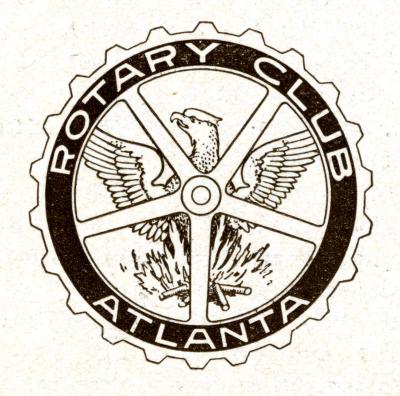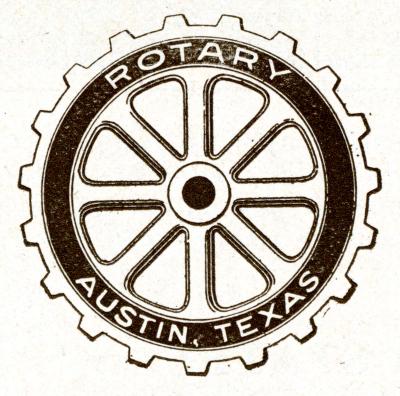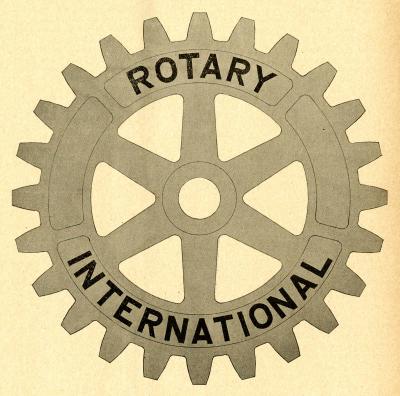Rotary History
How Rotary’s emblem evolved

Rotary Club of Chicago emblem, circa 1906.
The Rotary wheel, unchanged since 1924, was redesigned many times in the early years of the organization.
A Rotary Club of Chicago emblem that featured a wagon wheel influenced early logos of other clubs and Rotary International.
Early club emblem
In 1905, Montague M. Bear, an engraver and member of the Rotary Club of Chicago, sketched a wagon wheel with 13 spokes as a club emblem. When fellow club members began to complain that the design was static and lifeless, Bear added flourishes that made the wheel appear to ride on a bed of clouds. Unfortunately, some members felt the clouds looked like dust, defying the laws of physics by being kicked up on both sides of the wheel. Bear responded by superimposing a banner with the words “Rotary Club” over the clouds.
Early association emblem
In 1911, Secretary Chesley R. Perry recommended that “action be taken by the National Association to establish the wheel as the basic part of the emblem of every Rotary club.” Clubs were invited to submit designs to an emblem committee before the 1912 convention in Duluth, Minnesota, USA.
The Duluth convention provided some definition. “The emblem consists of the basic principle of a wheel with gears cut on the outer edge. ... The spokes are to be so designed as to indicate strength; the object of the gears, or cogs, being two-fold: First to relieve the plainness of the design, and Second, to symbolize power.”
The word “Rotary” appeared at the top and “International Association” at the bottom. (Rotary became an international organization in 1912.) Clubs were encouraged to use a similar design, placing the name of their city at the bottom instead of “International Association.” The number of spokes and cogs was unspecified. As a result, many variations on the emblem were in use by 1918.




Oscar Bjorge’s design for the Rotary emblem, as published in the January 1920 issue of The Rotarian.
A standard emblem
To address the growing number of emblems, the Board appointed Charles Mackintosh, of the Rotary Club of Chicago, Illinois, USA, and Oscar Bjorge, of the Rotary Club of Duluth, Minnesota, USA, to the committee charged with standardizing the Rotary emblem.
Bjorge drafted an emblem with six spokes and 24 cogs, giving it a sturdy appearance. In this design, the number of teeth and spokes was intended to reflect a real, working gearwheel. The number of spokes and cogs did not reflect any specific aspect of Rotary’s history or its programs, and this is still true today.
In November 1919, the Board adopted Bjorge’s design and a detailed description, and the 1921 convention formally approved them. For many years, descriptions of the emblem simply referred to an article called “Redesigning the Rotary Wheel” in the January 1920 issue of The Rotarian, which announced the Board’s decision.
By 1924, Bjorge’s design had been modified to include a keyway. This addition has been attributed to Will R. Forker, of the Rotary Club of Los Angeles, California, USA. He was reported to have said Bjorge’s design made no provision for the transfer of power to or from a shaft, rendering the wheel idle. Forker perceived Rotary as a “living force,” and inserting a keyway into the hub made the new wheel a “real worker.”
In January 1924, the Board formally approved the emblem that was then in use. Not all written descriptions were updated immediately, however. To clear up any confusion caused by the various decisions about the emblem between 1912 and 1929, a standard description of the existing design, with a keyway, was approved by the 1929 convention.
A mark of excellence

The Rotary emblem today.
For many years, the wheel stood alone as our logo. Although the words “Rotary International” are embedded in the wheel, they’re hard to read from a distance. So in 2013, Rotary expanded the official logo to include the word “Rotary” next to the wheel.
The Rotary wheel remains our mark of excellence. In addition to being part of the official logo, it may be enlarged for greater impact and used separately but near the logo.
Using the emblem
The Rotary emblem, like Rotary’s name and other logos, is a registered trademark. Clubs, districts, and Rotary Entities are welcome to use the Rotary emblem subject to the guidelines for the use of the Rotary Marks as set forth by the RI Board of Directors. These guidelines govern the use of the Rotary Marks on all merchandise, promotional materials, and publications, including domain names and websites.
For current guidelines on size and placement, see Rotary’s voice and visual identity guidelines. Clubs can download the logo and find templates to create club logos in our Brand Center.
